Existing User Log In
New User Registration
Register for a free account to gain full access to the VGChartz Network and join our thriving community.



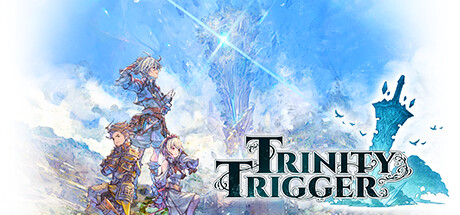

America - Front
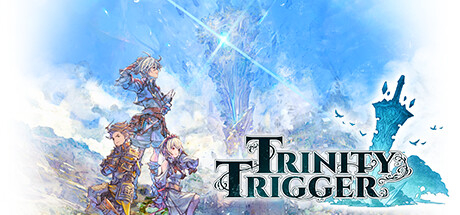

America - Back

FuRyu Corporation
Role-Playing
 (Add Date)
(Add Date) (Add Date)
(Add Date) (Add Date)
(Add Date)
| Owners: | 0 |
| Favorite: | 0 |
| Tracked: | 0 |
| Wishlist: | 0 |
| Now Playing: | 0 |
It shouldn't come as a surprise that many modern role-playing game developers keep looking backward to the 1990s for inspiration. That decade was a wonderland for RPG enthusiasts thanks to classics like Chrono Trigger, Suikoden, and Final Fantasy VII — not to mention a crucible of experimentation that established role-playing mechanics, systems, and tropes that endure to this day. One of the legendary titles from that generation was Secret of Mana, the DNA of which is alive and well in this year's Trinity Trigger from studio Three Rings. Thanks to its focus on cooperative real-time combat and a soundtrack scored by Hiroki Kikuta, it successfully channels the spirit of the 1993 SNES game while telling its own story set in a brand new world.
Trinity Trigger takes place in the land of Trinitia, a medieval land filled with towns, mountains, deserts, forests, and, unusually, mammoth weapons embedded in the earth. Left behind by the gods eons ago, these weapons, or Armas as they're called, are powerful, sacred sites to the people of Trinitia, many of whom still pray to the ancient deities of Chaos and Order. Legend tells of an ongoing proxy war fought by these gods, who once in a generation appoint two champions — one of Chaos and one of Order — to battle to the death to determine which side will dominate the world. The hero of the story is the young scavenger Cyan, burdened with the mantle of Warrior of Chaos. Accompanied by companions Elise and Zantis, Cyan embarks on a quest to defy his appointed fate, and perhaps save Trinitia in the process.
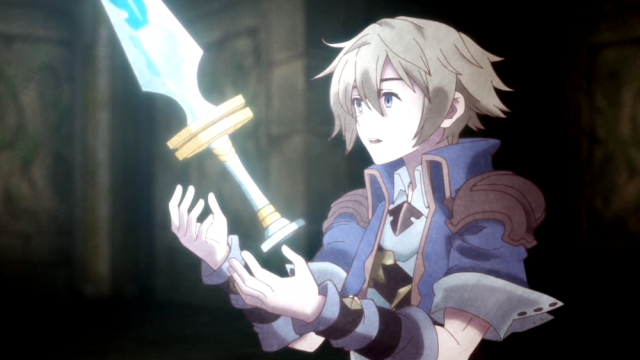
The story in general in Trinity Trigger is only okay. It's helped along by some charismatic protagonists, but it lacks the emotional depth and pathos required to stand out. Where the game does make a splash, though, is in its mythology. The premise of Trinitia, a former battleground of the gods littered with their gigantic weapons, is fascinating, as is the game's nuanced take on chaos and order. Rather than pigeonholing these concepts into categories of good and evil, Three Rings explains that absolute order and absolute chaos can both be detrimental, and that both should exist in moderation. Chaos isn't just bedlam; at its best, it's freedom and improvisation. Order isn't just stability; at its worst, it's tyranny and stagnation.
Three Rings touches again and again on these themes throughout Cyan's adventure, which takes him and his party across all of Trinitia. The basic flow of the game is as follows: Cyan, Elise, and Zantis, along with their Triggers — elemental spirits who transform into weapon forms — travel through the monster-infested wilderness to reach a settlement, visit the nearby Arma to power up their Triggers, depart, and then repeat the process. The Armas are as big as buildings, and so function as dungeons. Thus, the game takes on a predictable loop of overworld, town, dungeon. There are some diversions along the way, including an extended stay in Trinitia's capital city, but for the most part Trinity Trigger settles into a familiar, unexciting routine.
Three Rings attempts to break up the routine in Trinity Trigger with environmental diversity. Each biome through which the party treks is defined by some interesting twist of nature. There are wooded areas filled with spore-producing bushes, foggy ghost towns, arid deserts dotted with sandy whirlpools, and a volcanic region with dangerous blue and orange fire. There's even a fun, slightly-fourth wall breaking exchange with the characters where one explains that a desert can exist adjacent to a snowy region because each Arma rewrites the climate and geography of the nearby area — thus explaining away some of the illogic of classic video game design.
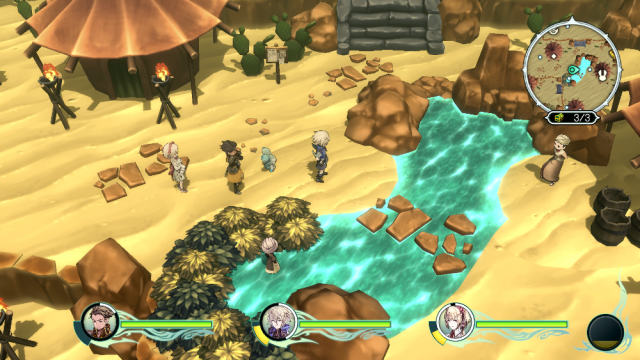
Even with its geographic diversity, the game maintains a feeling of sameness. While each Arma from the outside is spectacular and unique, the inside layouts and pathways are awfully similar (Trinity Trigger introduces some puzzle elements in later dungeons, but they don't add much to the experience). Towns, while set in different elevations and climates, have a copy-and-paste feel to them, with samey NPCs, assets, and voice samples.
The structure and rhythm of the campaign in Trinity Trigger might be lacking, but its moment-to-moment gameplay is quite entertaining. It plays similarly to Secret of Mana, with a threesome of adventurers fighting monsters in real time with a wide variety of weapons. Each weapon has several offensive options: a three-strike combo, a weapon aura, and a Trigger strike. In combat, you will most often deploy your three-hit combo with the A button, while building up your weapon aura gauge and Trigger strike energy. Once your weapon aura is full, press Y to activate the aura boon, e.g. increased offensive output or enhanced critical hit chance. At the same time you might press X to deliver a powerful area of effect strike against surrounding monsters.
Interestingly, you can't spam any of these attacks, in part because the more powerful ones require time to recharge and in part because each basic strike depletes your synchro gauge (think stamina bar). As a result, you need to space your attacks, conserve your energy, and dodge where appropriate. Luckily, if you dodge just at the moment the enemy attacks, you'll pull off what's called a "close call", which refills some of the aura and synchro gauges. This nuanced battle system brings a rewarding tactical element to the proceedings. And things only get more strategic with weapon weaknesses. Certain monsters are vulnerable to swords and bows, but resistant to axes and spears, for example. You must switch weapons and swap members on the fly to find the most effective combination.
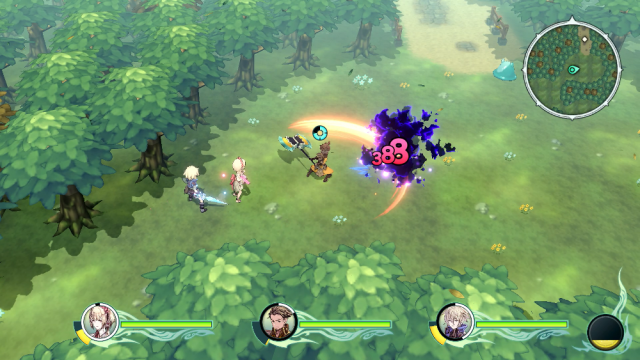
Deploying weapons in battle is only half of the equation, though. A big part of the fun of Trinity Trigger is customizing those weapons ahead of battle. Indeed, you could get lost in the game's weapons and crafting menus as you try to design the perfect build for Cyan, Elise, and Zantis. Not only can you customize the individual moves that make up each weapon's three-hit combo, but you can use accumulated SP — earned in battle — to upgrade each move several times over. Moreover, you can buy and craft "Mananite" to insert into multiple slots per weapon, granting them additional effects like HP regeneration upon critical hit, defense boosts, resistance to poison, etc. The opportunities for experimentation are abundant in Trinity Trigger.
You'll need to consistently level up your weapon attacks and invest in new Mananite to keep up with the game's difficulty curve. For the most part, the curve is steady, but it tends to spike here and there during boss battles, which can devolve into drawn-out slugfests. Each boss comes with a special armor gauge, which must be depleted before the heroic threesome can do any real damage. Since the armor gauge refills after a time, the fights can sometimes feel needlessly drawn out. The final boss is especially challenging in this respect. If you're not appropriately leveled and you don't have the right Mananite equipped, don't bother.
Fortunately Three Rings established a generous feature called "Retry", which revives the party in the area before a boss battle with full HP restored to full, and with the boss' armor gauge reduced by 10 percent (it will decrease with each subsequent Retry for a max total of 50 percent). This is a great way to give players who don't want to grind for levels or resources a path forward, without removing the challenge altogether.
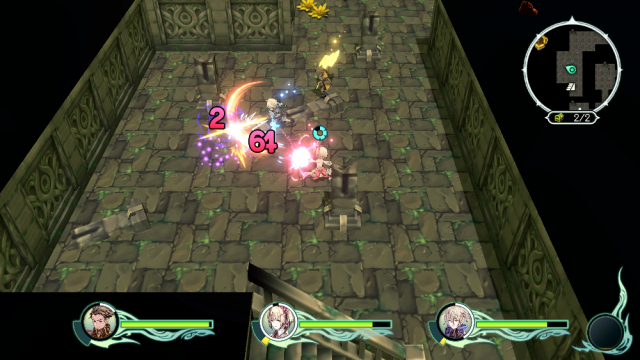
The armor gauge isn't the only thing that makes boss battles taxing. The other element is the game's partner AI, which, while adequate overall, tends to get itself in trouble in climactic fights. If you leave your partner characters to their own devices for too long, they will most likely get themselves killed. You do have the option to activate an "ally auto-item" that allows allies to use healing items freely, but you can't change the AI logic in any other ways, for example formation or aggression. You might find yourself yelling at the screen as your companions walk right into a telegraphed attack.
The best way to overcome this issue is to take advantage of the game's local multiplayer options, and replace the computer-controlled characters with a real-life friend or two — although this too comes with a couple warts. The good news is that local co-op is entirely drop-in, drop-out. With a quick switch in the in-game settings menu, you can activate one or two additional players. It's great fun to march around Trinitia with a couple of friends, fighting monsters and tackling quests together. The bad news is that it's an unequal experience for the additional players. They have to wait for the main player to activate quests and customize weapons on their behalf. Furthermore, local co-op isn't even an option until Zantis joins the party, about three hours into the game. If you're looking for a complete co-op experience from beginning to end, this isn't exactly it.
Still, if your friends don't mind playing second and third fiddle, there's a lot to do together. The main campaign should take around 20 hours, give or take a few depending on how much side content you tackle, and you can even return to Trinitia after the credits roll to complete unfinished quests.
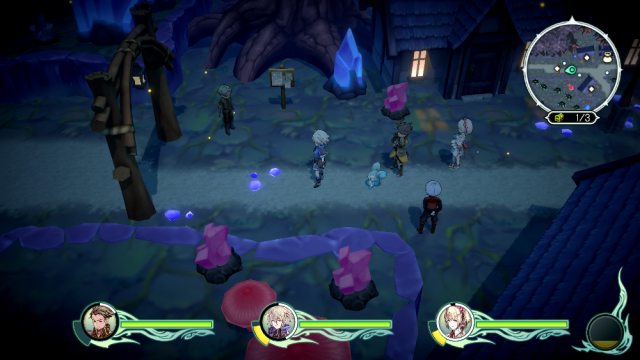
On the graphical side of things, Trinity Trigger presents itself as an "AA" title with some recycled and/or generic assets. Nothing really stands out about the game's models, textures, and lighting; it's all very serviceable. One area where the development team appeared to spare no expense, though, is the hand-drawn animation that pops up in still frames when an Arma is introduced or in animated cut-scenes that play at the beginning and end of the game. These are gorgeous, but rare.
In terms of sound, the game excels in voice acting, despite the same combat voice samples repeated ad nauseam, and features some wonderfully nostalgic music. The soundtrack to Trinity Trigger, composed by the man who scored Secret of Mana 30 years ago, Hiroki Kikuta, helps bridge the gap between past and present, and delivers a bunch of good tunes along the way. The standout track is absolutely the bouncy, cheery "Days of Wind and Rainbow".
Thanks to Kikuta's music, and an action-role-playing framework focused around a threesome of heroes, Trinity Trigger successfully channels the spirit of the Secret of Mana. It never manages to reach the mechanical and stylistic heights of its inspiration, due to its ordinary storytelling, generic art direction, and a predictable gameplay loop, but overall it's a decent RPG with a good amount of content, some likable characters, and an engaging tactical weapons system. If you don't have an emotional connection to Secret of Mana, consider placing this one on your wish list and waiting for a sale. If you love all things Mana, though, it's safe to go ahead and pull the trigger.









